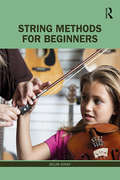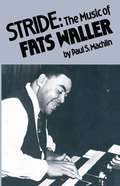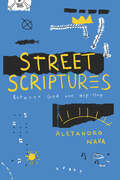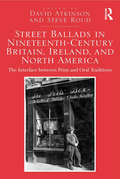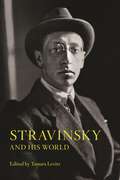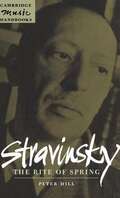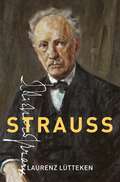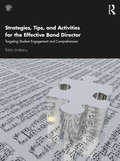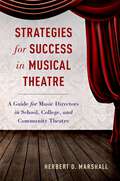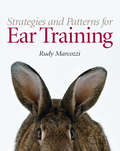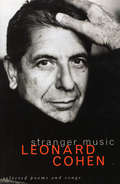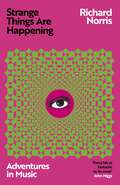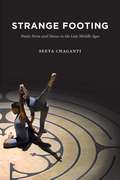- Table View
- List View
String Methods for Beginners
by Selim GirayString Methods for Beginners is designed for students to receive the essential playing and teaching skills on all orchestral string instruments. The goal of this textbook is to be truly methodical in its approach, and to assist the instructor, completely eliminating the need to do additional research, or reorganization in preparation to teach this class. Students will gain the basic knowledge and experience to teach bowed stringed instruments in public schools. String Methods for Beginners covers the necessary topics to learn and teach the violin, viola, cello, and string bass. It explores the fundamentals of those instruments and teaching considerations, utilizing a heterogeneous approach. As the primary resource to any college- and university-level String Techniques, String Methods, or Instrumental Methods class, this course book fits into a standard semester, comprised of 25 lessons, which correspond with two hourly classes per week for the term. It provides the instructor with the tools to teach a classroom of non-majors or string education majors, or a mixed classroom of both. FEATURES Offers a blueprint for a semester long string methods course. For beginning students, and also comprehensive for more in-depth study or for reference. Logical, step-by-step "recipe-like" approach.
Stride: The Music of Fats Waller
by Paul S MachlinAlready known as a Wagner scholar for his work on the sketches of the Flying Dutchman, Paul Machlin has for many years taken a scholarly interest in the school of Harlem 'stride' jazz pianists. Stride: The Music of Fats Waller is a full analysis of the piano music of Waller as composer, soloist and recording artist. 38 music examples illustrate Waller's complex keyboard style and improvisatory techniques. The discussion of Waller's piano music is set in the context of a biographical study, and a discography listing all known recordings by the pianist.
Street Scriptures: Between God and Hip-Hop
by Alejandro NavaThis book explores an important aspect of hip-hop that is rarely considered: its deep entanglement with spiritual life. The world of hip-hop is saturated with religion, but rarely is that element given serious consideration. In Street Scriptures, Alejandro Nava focuses our attention on this aspect of the music and culture in a fresh way, combining his profound love of hip-hop, his passion for racial and social justice, and his deep theological knowledge. Street Scriptures offers a refreshingly earnest and beautifully written journey through hip-hop’s deep entanglement with the sacred. Nava reveals a largely unheard religious heartbeat in hip-hop, exploring crosscurrents of the sacred and profane in rap, reggaeton, and Latinx hip-hop today. Ranging from Kendrick Lamar, Chance the Rapper, Lauryn Hill, Cardi B, and Bad Bunny to St. Augustine and William James, Nava examines the ethical-political, mystical-prophetic, and theological qualities in hip-hop, probing the pure sonic and aesthetic signatures of music, while also diving deep into the voices that invoke the spirit of protest. The result is nothing short of a new liberation theology for our time, what Nava calls a “street theology.”
Street Ballads in Nineteenth-Century Britain, Ireland, and North America: The Interface between Print and Oral Traditions
by David Atkinson Steve RoudIn recent years, the assumption that traditional songs originated from a primarily oral tradition has been challenged by research into ’street literature’ - that is, the cheap printed broadsides and chapbooks that poured from the presses of jobbing printers from the late sixteenth century until the beginning of the twentieth. Not only are some traditional singers known to have learned songs from printed sources, but most of the songs were composed by professional writers and reached the populace in printed form. Street Ballads in Nineteenth-Century Britain, Ireland, and North America engages with the long-running debate over the origin of traditional songs by examining street literature’s interaction with, and influence on, oral traditions.
Street Ballads in Nineteenth-Century Britain, Ireland, and North America: The Interface between Print and Oral Traditions
by David Atkinson Steve RoudIn recent years, the assumption that traditional songs originated from a primarily oral tradition has been challenged by research into ’street literature’ - that is, the cheap printed broadsides and chapbooks that poured from the presses of jobbing printers from the late sixteenth century until the beginning of the twentieth. Not only are some traditional singers known to have learned songs from printed sources, but most of the songs were composed by professional writers and reached the populace in printed form. Street Ballads in Nineteenth-Century Britain, Ireland, and North America engages with the long-running debate over the origin of traditional songs by examining street literature’s interaction with, and influence on, oral traditions.
Stravinsky and His World
by Tamara LevitzStravinsky and His World brings together an international roster of scholars to explore fresh perspectives on the life and music of Igor Stravinsky. Situating Stravinsky in new intellectual and musical contexts, the essays in this volume shed valuable light on one of the most important composers of the twentieth century. Contributors examine Stravinsky's interaction with Spanish and Latin American modernism, rethink the stylistic label "neoclassicism" with a section on the ideological conflict over his lesser-known opera buffa Mavra, and reassess his connections to his homeland, paying special attention to Stravinsky's visit to the Soviet Union in 1962. The essays also explore Stravinsky's musical and religious differences with Arthur Lourié, delve into Stravinsky's collaboration with Pyotr Suvchinsky and Roland-Manuel in the genesis of his groundbreaking Poetics of Music, and look at how the movement within stasis evident in the scores of Stravinsky's Orpheus and Oedipus Rex reflected the composer's fierce belief in fate. Rare documents--including Spanish and Mexican interviews, Russian letters, articles by Arthur Lourié, and rarely seen French and Russian texts--supplement the volume, bringing to life Stravinsky's rich intellectual milieu and intense personal relationships. The contributors are Tatiana Baranova, Leon Botstein, Jonathan Cross, Valérie Dufour, Gretchen Horlacher, Tamara Levitz, Klára Móricz, Leonora Saavedra, and Svetlana Savenko.
Stravinsky and His World
by Tamara LevitzStravinsky and His World brings together an international roster of scholars to explore fresh perspectives on the life and music of Igor Stravinsky. Situating Stravinsky in new intellectual and musical contexts, the essays in this volume shed valuable light on one of the most important composers of the twentieth century. Contributors examine Stravinsky's interaction with Spanish and Latin American modernism, rethink the stylistic label "neoclassicism" with a section on the ideological conflict over his lesser-known opera buffa Mavra, and reassess his connections to his homeland, paying special attention to Stravinsky's visit to the Soviet Union in 1962. The essays also explore Stravinsky's musical and religious differences with Arthur Lourié, delve into Stravinsky's collaboration with Pyotr Suvchinsky and Roland-Manuel in the genesis of his groundbreaking Poetics of Music, and look at how the movement within stasis evident in the scores of Stravinsky's Orpheus and Oedipus Rex reflected the composer's fierce belief in fate. Rare documents--including Spanish and Mexican interviews, Russian letters, articles by Arthur Lourié, and rarely seen French and Russian texts--supplement the volume, bringing to life Stravinsky's rich intellectual milieu and intense personal relationships. The contributors are Tatiana Baranova, Leon Botstein, Jonathan Cross, Valérie Dufour, Gretchen Horlacher, Tamara Levitz, Klára Móricz, Leonora Saavedra, and Svetlana Savenko.
Strauss (Master Musicians Series)
by Laurenz LüttekenRichard Strauss is an outlier in the context of twentieth century music. Some consider him a composer of the late romantic period, while others declare him a traitor of modernity for his role in National Socialism. Despite the controversy surrounding him, Strauss's works--even beyond his most well-known operas Elektra and Rosenkavalier--are present in the repertories of concert halls worldwide and continue to enjoy large audiences. The details of the composer's life, however, remain shrouded in mystery and gossip. Laurenz Lütteken's Strauss presents a fresh approach to understanding this elusive composer's life and works. Dispensing with stereotypes and sensationalism, it reveals Strauss to be a sensitive intellectual and representative of modernity, with all light and shade of the turn of the twentieth century.
Strauss (Master Musicians Series)
by Laurenz LüttekenRichard Strauss is an outlier in the context of twentieth century music. Some consider him a composer of the late romantic period, while others declare him a traitor of modernity for his role in National Socialism. Despite the controversy surrounding him, Strauss's works--even beyond his most well-known operas Elektra and Rosenkavalier--are present in the repertories of concert halls worldwide and continue to enjoy large audiences. The details of the composer's life, however, remain shrouded in mystery and gossip. Laurenz Lütteken's Strauss presents a fresh approach to understanding this elusive composer's life and works. Dispensing with stereotypes and sensationalism, it reveals Strauss to be a sensitive intellectual and representative of modernity, with all light and shade of the turn of the twentieth century.
Strategies, Tips, and Activities for the Effective Band Director: Targeting Student Engagement and Comprehension
by Robin LinaberryStrategies, Tips, and Activities for the Effective Band Director: Targeting Student Engagement and Comprehension is a resourceful collection of highly effective teaching strategies, solutions, and activities for band directors. Chapters are aligned to cover common topics, presenting several practical lesson ideas for each topic. In most cases, each pedagogical suggestion is supported by excerpts from standard concert band literature. Topics covered include: score study shortcuts; curriculum development; percussion section management; group and individual intonation; effective rehearsal strategies; and much more! This collection of specific concepts, ideas, and reproducible pedagogical methods—not unlike short lesson plans—can be used easily and immediately. Ideal for band directors of students at all levels, Strategies, Tips, and Activities for the Effective Band Director is the product of more than three decades of experience, presenting innovative approaches, as well as strategies that have been borrowed, revised, and adapted from scores of successful teachers and clinicians.
Strategies, Tips, and Activities for the Effective Band Director: Targeting Student Engagement and Comprehension
by Robin LinaberryStrategies, Tips, and Activities for the Effective Band Director: Targeting Student Engagement and Comprehension is a resourceful collection of highly effective teaching strategies, solutions, and activities for band directors. Chapters are aligned to cover common topics, presenting several practical lesson ideas for each topic. In most cases, each pedagogical suggestion is supported by excerpts from standard concert band literature. Topics covered include: score study shortcuts; curriculum development; percussion section management; group and individual intonation; effective rehearsal strategies; and much more! This collection of specific concepts, ideas, and reproducible pedagogical methods—not unlike short lesson plans—can be used easily and immediately. Ideal for band directors of students at all levels, Strategies, Tips, and Activities for the Effective Band Director is the product of more than three decades of experience, presenting innovative approaches, as well as strategies that have been borrowed, revised, and adapted from scores of successful teachers and clinicians.
Strategies for Success in Musical Theatre: A Guide for Music Directors in School, College, and Community Theatre
by Herbert D. MarshallIn Strategies for Success in Musical Theatre, veteran musical director and teacher Herbert Marshall provides an essential how-to guide for teachers or community members who find themselves in charge of music directing a show. Stepping off the podium, Marshall offers practical and often humorous real-world advice on managing auditions; organizing rehearsals; working with a choir, choreographer, and leads; how to run a sitzprobe, a technical rehearsal, and a dress rehearsal; how to manage the cast and crew energy for a successful opening night; and ways to end the experience on a high note for all involved. Throughout the book, Marshall emphasizes the importance of learning through performance and the beauty of a group united in a common goal. In doing so, he turns what can appear as a never-ending list of tasks and demand for specialized knowledge into a manageable, educational, and ultimately engaging and fun experience for all. Because the techniques in Marshall's book have been thoroughly workshopped and classroom tested, they are based in proven pedagogy and will be of particular use for the music director in acting as a teaching director: someone imparting theatrical knowledge to his or her cast and production staff. Marshall provides both extended and abbreviated timelines, flexible to fit any director's needs. Marshall's book is a greatly beneficial resource for music education students and teachers alike, giving an insightful glimpse into the range of possibilities within a music educator's career. Musicians and actors with varying levels of skill and experience will be able to grow simultaneously through Marshall's innovative teaching plans. Through collaborative techniques, steps in the book serve to educate both director and student. Thoroughly illustrated with charts, diagrams, and scores, Strategies for Success in Musical Theatre is an ideal companion for all who work with school and community based musical theater productions.
Strategies and Patterns for Ear Training
by Rudy MarcozziA complete, progressive course that teaches musicians how to notate music from audio examples, held on downloadable resources. Basic melodic dictation is followed by progressively more complex scores, in classical, jazz, and popular styles. Designed for the two year undergraduate sequence, Strategies and Patterns for Ear Training offers valuable strategies to students and teachers alike.
Strategies and Patterns for Ear Training
by Rudy MarcozziA complete, progressive course that teaches musicians how to notate music from audio examples, held on downloadable resources. Basic melodic dictation is followed by progressively more complex scores, in classical, jazz, and popular styles. Designed for the two year undergraduate sequence, Strategies and Patterns for Ear Training offers valuable strategies to students and teachers alike.
STRATEG FOR SUCCESS IN MUS THEATRE C: A Guide for Music Directors in School, College, and Community Theatre
by Herbert D. MarshallIn Strategies for Success in Musical Theatre, veteran musical director and teacher Herbert Marshall provides an essential how-to guide for teachers or community members who find themselves in charge of music directing a show. Stepping off the podium, Marshall offers practical and often humorous real-world advice on managing auditions; organizing rehearsals; working with a choir, choreographer, and leads; how to run a sitzprobe, a technical rehearsal, and a dress rehearsal; how to manage the cast and crew energy for a successful opening night; and ways to end the experience on a high note for all involved. Throughout the book, Marshall emphasizes the importance of learning through performance and the beauty of a group united in a common goal. In doing so, he turns what can appear as a never-ending list of tasks and demand for specialized knowledge into a manageable, educational, and ultimately engaging and fun experience for all. Because the techniques in Marshall's book have been thoroughly workshopped and classroom tested, they are based in proven pedagogy and will be of particular use for the music director in acting as a teaching director: someone imparting theatrical knowledge to his or her cast and production staff. Marshall provides both extended and abbreviated timelines, flexible to fit any director's needs. Marshall's book is a greatly beneficial resource for music education students and teachers alike, giving an insightful glimpse into the range of possibilities within a music educator's career. Musicians and actors with varying levels of skill and experience will be able to grow simultaneously through Marshall's innovative teaching plans. Through collaborative techniques, steps in the book serve to educate both director and student. Thoroughly illustrated with charts, diagrams, and scores, Strategies for Success in Musical Theatre is an ideal companion for all who work with school and community based musical theater productions.
Stranger Than Kindness
by Nick CaveStranger Than Kindness is a journey in images and words into the creative world of musician, storyteller and cultural icon Nick Cave. This highly collectable book invites the reader into the innermost core of the creative process and paves the way for an entirely new and intimate meeting with the artist, presenting Cave’s life, work and inspiration and exploring his many real and imagined universes. It features full colour reproductions of original artwork, handwritten lyrics, photographs and collected personal artefacts along with commentary and meditations from Nick Cave, Janine Barrand and Darcey Steinke. Stranger Than Kindness asks what shapes our lives and makes us who we are, and celebrates the curiosity and power of the creative spirit. The book has been developed and curated by Nick Cave in collaboration with Christina Back. The images were selected from ‘Stranger Than Kindness: The Nick Cave Exhibition’, opening at the Royal Danish Library in Copenhagen in March 2020.
Stranger Music: Selected Poems and Songs
by Leonard CohenLeonard Cohen's legacy is that of one of the most literate, daring, and affecting poet-songwriters in the world. Stranger Music presents a magnificent cross-section of Cohen's work - including the legendary songs 'Suzanne', 'Joan of Arc' and 'The Chelsea Hotel', and elections from such books as Flowers for Hitler, Beautiful Losers, and Death of a Lady's Man, and eleven previously unpublished poems.Stranger Music brings together Cohen's song lyrics and a generous selection of his poetry and is a celebration of the legendary musician's extraordinary gift for language that speaks with rare clarity, passion and timelessness.'A massive record of the poet's imaginative journey, through beauty, through horror, through the extremes of love and despair, from the deepest abyss of self-abnegation to the rare and necessary moments of ecstasy. The language ranges from the exquisitely beautiful to the darkly obscene, from the romantically inspired to the ironically banal... A poetic record like no other' Toronto Star
Strange Things Are Happening
by Richard Norris'The rainbow reaches right across the sky, for miles and miles, and has landed right in the middle of our field. My mother, Alison, is standing at the beginning. I'm sure it's a beginning, rather than the end, as there's no pot of gold in sight. The point where everything forms or, perhaps, is not quite formed as yet. That's my favourite place. A place alive with possibility.'Strange Things Are Happening begins with the wonder of that rainbow, and continues with many escapades down the rabbit hole. From punk and the beginnings of the DIY scene, through Acid House, psychedelia, the rise of electronic dance music and much more, Richard Norris has been involved in countless countercultural revolutions. From misadventures in Amsterdam with Timothy Leary, with Sun Ra at customs, and Shaun Ryder in Joe Strummer's beaten up Cadillac in Tijuana, to his extraordinarily influential output in The Grid and Beyond The Wizards Sleeve, Richard Norris' story is one of collaboration and community, fuelled by relentless psychedelic curiosity.Strange Things Are Happening is a record of a life lived in the moment, forever in thrall to discovery, exploration and innovation - the search for what lies at the other end of that rainbow.
Strange Fruit: Billie Holiday, Café Society And An Early Cry For Civil Rights (Running Press Ser.)
by David MargolickThe story of the song that foretold a movement and the Lady who dared sing it. Billie Holiday's signature tune, 'Strange Fruit', with its graphic and heart-wrenching portrayal of a lynching in the South, brought home the evils of racism as well as being an inspiring mark of resistance. The song's powerful, evocative lyrics - written by a Jewish communist schoolteacher - portray the lynching of a black man in the South. In 1939, its performance sparked controversy (and sometimes violence) wherever Billie Holiday went. Not until sixteen years later did Rosa Parks refuse to yield her seat on a Montgomery, Alabama bus. Yet 'Strange Fruit' lived on, and Margolick chronicles its effect on those who experienced it first-hand: musicians, artists, journalists, intellectuals, students, budding activists, even the waitresses and bartenders who worked the clubs.
Strange Footing: Poetic Form and Dance in the Late Middle Ages
by Seeta ChagantiFor premodern audiences, poetic form did not exist solely as meter, stanzas, or rhyme scheme. Rather, the form of a poem emerged as an experience, one generated when an audience immersed in a culture of dance encountered a poetic text. Exploring the complex relationship between medieval dance and medieval poetry, Strange Footing argues that the intersection of texts and dance produced an experience of poetic form based in disorientation, asymmetry, and even misstep. Medieval dance guided audiences to approach poetry not in terms of the body’s regular marking of time and space, but rather in the irregular and surprising forces of virtual motion around, ahead of, and behind the dancing body. Reading medieval poems through artworks, paintings, and sculptures depicting dance, Seeta Chaganti illuminates texts that have long eluded our full understanding, inviting us to inhabit their strange footings askew of conventional space and time. Strange Footing deploys the motion of dance to change how we read medieval poetry, generating a new theory of poetic form for medieval studies and beyond.
Strange Footing: Poetic Form and Dance in the Late Middle Ages
by Seeta ChagantiFor premodern audiences, poetic form did not exist solely as meter, stanzas, or rhyme scheme. Rather, the form of a poem emerged as an experience, one generated when an audience immersed in a culture of dance encountered a poetic text. Exploring the complex relationship between medieval dance and medieval poetry, Strange Footing argues that the intersection of texts and dance produced an experience of poetic form based in disorientation, asymmetry, and even misstep. Medieval dance guided audiences to approach poetry not in terms of the body’s regular marking of time and space, but rather in the irregular and surprising forces of virtual motion around, ahead of, and behind the dancing body. Reading medieval poems through artworks, paintings, and sculptures depicting dance, Seeta Chaganti illuminates texts that have long eluded our full understanding, inviting us to inhabit their strange footings askew of conventional space and time. Strange Footing deploys the motion of dance to change how we read medieval poetry, generating a new theory of poetic form for medieval studies and beyond.
Strange Footing: Poetic Form and Dance in the Late Middle Ages
by Seeta ChagantiFor premodern audiences, poetic form did not exist solely as meter, stanzas, or rhyme scheme. Rather, the form of a poem emerged as an experience, one generated when an audience immersed in a culture of dance encountered a poetic text. Exploring the complex relationship between medieval dance and medieval poetry, Strange Footing argues that the intersection of texts and dance produced an experience of poetic form based in disorientation, asymmetry, and even misstep. Medieval dance guided audiences to approach poetry not in terms of the body’s regular marking of time and space, but rather in the irregular and surprising forces of virtual motion around, ahead of, and behind the dancing body. Reading medieval poems through artworks, paintings, and sculptures depicting dance, Seeta Chaganti illuminates texts that have long eluded our full understanding, inviting us to inhabit their strange footings askew of conventional space and time. Strange Footing deploys the motion of dance to change how we read medieval poetry, generating a new theory of poetic form for medieval studies and beyond.
Strange Footing: Poetic Form and Dance in the Late Middle Ages
by Seeta ChagantiFor premodern audiences, poetic form did not exist solely as meter, stanzas, or rhyme scheme. Rather, the form of a poem emerged as an experience, one generated when an audience immersed in a culture of dance encountered a poetic text. Exploring the complex relationship between medieval dance and medieval poetry, Strange Footing argues that the intersection of texts and dance produced an experience of poetic form based in disorientation, asymmetry, and even misstep. Medieval dance guided audiences to approach poetry not in terms of the body’s regular marking of time and space, but rather in the irregular and surprising forces of virtual motion around, ahead of, and behind the dancing body. Reading medieval poems through artworks, paintings, and sculptures depicting dance, Seeta Chaganti illuminates texts that have long eluded our full understanding, inviting us to inhabit their strange footings askew of conventional space and time. Strange Footing deploys the motion of dance to change how we read medieval poetry, generating a new theory of poetic form for medieval studies and beyond.
Strange Footing: Poetic Form and Dance in the Late Middle Ages
by Seeta ChagantiFor premodern audiences, poetic form did not exist solely as meter, stanzas, or rhyme scheme. Rather, the form of a poem emerged as an experience, one generated when an audience immersed in a culture of dance encountered a poetic text. Exploring the complex relationship between medieval dance and medieval poetry, Strange Footing argues that the intersection of texts and dance produced an experience of poetic form based in disorientation, asymmetry, and even misstep. Medieval dance guided audiences to approach poetry not in terms of the body’s regular marking of time and space, but rather in the irregular and surprising forces of virtual motion around, ahead of, and behind the dancing body. Reading medieval poems through artworks, paintings, and sculptures depicting dance, Seeta Chaganti illuminates texts that have long eluded our full understanding, inviting us to inhabit their strange footings askew of conventional space and time. Strange Footing deploys the motion of dance to change how we read medieval poetry, generating a new theory of poetic form for medieval studies and beyond.
